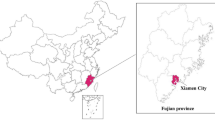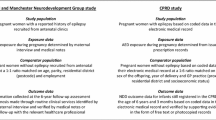Abstract
Introduction
The POMME (PrescriptiOn Médicaments Mères Enfants) cohort has been implemented for the evaluation of the long-term consequences of medicine prenatal exposure. It holds anonymous medical information as well as information on medicine and healthcare reimbursement to the children, from the first day of intra-uterine life until childhood.
Objective
This article provides a description of the cohort regarding its structure and content and presents an outlook of the studies that could be performed with this new data source.
Methods
Data sources include (1) the French Health Insurance Database (medicines and medical care prescriptions and reimbursements to children and mothers during pregnancy) and (2) the Mother and Child Protection Centre Database (child health certificates at birth, 9 months of age and 24 months of age). Children born in Haute-Garonne (south-west France), over a period of 1 year (from 1 July to 30 June), are registered in POMME every 5 years. The cohort began on 1 July, 2010.
Results
To date, 8372 children have been recorded in POMME. They have reached 7 years of age now. Among them, 4249 (50.8%) are boys, 286 (3.4%) were from multiple pregnancies and 519 (6.2%) were born prematurely. They were prenatally exposed to 9.8 ± 6.1 medications. After birth, drug exposure was greatest in children aged 0–2 years. Children were mostly exposed to paracetamol, anti-infective agents and respiratory system drugs; 908 (10.8%) children presented with at least two signs of psychomotor development disorders.
Conclusions
POMME provides an observatory study on drug exposure and medical care use in children. This innovative cohort would make it possible to assess the risk of the long-term consequences of prenatal medicine exposure.



Similar content being viewed by others
Notes
Mothers’ and children’s drug prescriptions.
Information Systems Security Unit.
References
Christensen J, Grønborg TK, Sørensen MJ, Schendel D, Parner ET, Pedersen LH, et al. Prenatal valproate exposure and risk of autism spectrum disorders and childhood autism. JAMA. 2013;309(16):1696–703.
Bliddal M, Broe A, Pottegård A, Olsen J, Langhoff-Roos J. The Danish Medical Birth Register. Eur J Epidemiol. 2018;33(1):27–36.
Magnus P, Birke C, Vejrup K, Haugan A, Alsaker E, Daltveit AK, et al. Cohort profile update: the Norwegian Mother and Child Cohort Study (MoBa). Int J Epidemiol. 2016;45(2):382–8.
Base des médicaments et informations tarifaires. http://www.codage.ext.cnamts.fr/codif/bdm_it/index_presentation.php?p_site=AMELI. Accessed 19 Jul 2018.
US Food and Drug Administration. Pediatric expertise for advisory panels: guidance for industry and FDA staff. https://www.fda.gov/RegulatoryInformation/Guidances/ucm082185.htm. Accessed 1 Mar 2018.
Palosse-Cantaloube L, Hurault-Delarue C, Beau A-B, Montastruc J-L, Lacroix I, Damase-Michel C. Risk of infections during the first year of life after in utero exposure to drugs acting on immunity: a population-based cohort study. Pharmacol Res. 2016;113(Pt A):557–62.
Bénard-Laribière A, Jové J, Lassalle R, Robinson P, Droz-Perroteau C, Noize P. Drug use in French children: a population-based study. Arch Dis Child. 2015;100(10):960–5.
Damase-Michel C, Lapeyre-Mestre M, Moly C, Fournié A, Montastruc JL. Drug use during pregnancy: survey in 250 women consulting at a university hospital center [in French]. J Gynecol Obstet Biol Reprod (Paris). 2000;29(1):77–85.
Pisa FE, Casetta A, Clagnan E, Michelesio E, Vecchi Brumatti L, Barbone F. Medication use during pregnancy, gestational age and date of delivery: agreement between maternal self-reports and health database information in a cohort. BMC Pregnancy Childbirth. 2015;25(15):310.
Cheung K, El Marroun H, Elfrink ME, Jaddoe VWV, Visser LE, Stricker BHC. The concordance between self-reported medication use and pharmacy records in pregnant women. Pharmacoepidemiol Drug Saf. 2017;26(9):1119–25.
Ylinen S, Hämeen-Anttila K, Sepponen K, Lindblad AK, Ahonen R. The use of prescription medicines and self-medication among children: a population-based study in Finland. Pharmacoepidemiol Drug Saf. 2010;19(10):1000–8.
Martín-Pérez M, López De Andrés A, Barcenilla González MÁ, Jiménez-García R, Hernández-Barrera V, Jiménez-Trujillo I, et al. Parental administration of over-the-counter medication to Spanish children: a population-based national study. J Spec Pediatr Nurs. 2016;21(2):64–73.
Du Y, Knopf H. Self-medication among children and adolescents in Germany: results of the National Health Survey for Children and Adolescents (KiGGS). Br J Clin Pharmacol. 2009;68(4):599–608.
Escourrou B, Bouville B, Bismuth M, Durrieu G, Oustric S. Self-medication in children by parents: a real risk? A cross-sectional descriptive study [in French]. Rev Prat. 2010;60(6 Suppl.):27–34.
Kogan MD, Pappas G, Yu SM, Kotelchuck M. Over-the-counter medication use among US preschool-age children. JAMA. 1994;272(13):1025–30.
Pereira FS, Bucaretchi F, Stephan C, Cordeiro R. Self-medication in children and adolescents. J Pediatr (Rio J). 2007;83(5):453–8.
Bezin J, Duong M, Lassalle R, Droz C, Pariente A, Blin P, et al. The national healthcare system claims databases in France, SNIIRAM and EGB: powerful tools for pharmacoepidemiology. Pharmacoepidemiol Drug Saf. 2017;26(8):954–62.
Clavenna A, Bonati M. Drug prescriptions to outpatient children: a review of the literature. Eur J Clin Pharmacol. 2009;65(8):749–55.
Pandolfini C, Bonati M. A literature review on off-label drug use in children. Eur J Pediatr. 2005;164(9):552–8.
Sturkenboom MCJM, Verhamme KMC, Nicolosi A, Murray ML, Neubert A, Caudri D, et al. Drug use in children: cohort study in three European countries. BMJ. 2008;24(337):a2245.
Clavenna A, Berti A, Gualandi L, Rossi E, De Rosa M, Bonati M. Drug utilisation profile in the Italian paediatric population. Eur J Pediatr. 2009;168(2):173–80.
Chai G, Governale L, McMahon AW, Trinidad JP, Staffa J, Murphy D. Trends of outpatient prescription drug utilization in US children, 2002–2010. Pediatrics. 2012;130(1):23–31.
Noordam R, Aarts N, Verhamme KM, Sturkenboom MCM, Stricker BH, Visser LE. Prescription and indication trends of antidepressant drugs in the Netherlands between 1996 and 2012: a dynamic population-based study. Eur J Clin Pharmacol. 2015;71(3):369–75.
Abbas S, Ihle P, Adler J-B, Engel S, Günster C, Linder R, et al. Psychopharmacological prescriptions in children and adolescents in Germany. Dtsch Arzteblatt Int. 2016;113(22–23):396–403.
Sohn M, Moga DC, Blumenschein K, Talbert J. National trends in off-label use of atypical antipsychotics in children and adolescents in the United States. Medicine (Baltimore). 2016;95(23):e3784.
Holstiege J, Schink T, Molokhia M, Mazzaglia G, Innocenti F, Oteri A, et al. Systemic antibiotic prescribing to paediatric outpatients in 5 European countries: a population-based cohort study. BMC Pediatr. 2014;5(14):174.
Skovlund E, Handal M, Selmer R, Brandlistuen RE, Skurtveit S. Language competence and communication skills in 3-year-old children after prenatal exposure to analgesic opioids. Pharmacoepidemiol Drug Saf. 2017;26(6):625–34.
Brandlistuen RE, Ystrom E, Hernandez-Diaz S, Skurtveit S, Selmer R, Handal M, et al. Association of prenatal exposure to benzodiazepines and child internalizing problems: a sibling-controlled cohort study. PLoS One. 2017;12(7):e0181042.
Rai D, Lee BK, Dalman C, Newschaffer C, Lewis G, Magnusson C. Antidepressants during pregnancy and autism in offspring: population based cohort study. BMJ. 2017;19(358):j2811.
Mao Y, Pedersen LH, Christensen J, Vestergaard M, Zhou W, Olsen J, et al. Prenatal exposure to antidepressants and risk of epilepsy in childhood. Pharmacoepidemiol Drug Saf. 2016;25(11):1320–30.
Würtz AM, Rytter D, Vestergaard CH, Christensen J, Vestergaard M, Bech BH. Prenatal exposure to antiepileptic drugs and use of primary healthcare during childhood: a population-based cohort study in Denmark. BMJ Open. 2017;7(1):e012836.
Würtz AML, Høstrup Vestergaard C, Rytter D, Sørensen MJ, Christensen J, Vestergaard M, et al. Prenatal exposure to antipsychotic medication and use of primary health care system in childhood: a population-based cohort study in Denmark. Clin Epidemiol. 2017;9:657–66.
ter Horst PGJ, Bos HJ, de Jong-van de Berg LTW, Wilffert B. In utero exposure to antidepressants and the use of drugs for pulmonary diseases in children. Eur J Clin Pharmacol. 2013;69(3):541–7.
Fraser A, Macdonald-Wallis C, Tilling K, Boyd A, Golding J, Davey Smith G, et al. Cohort profile: the Avon Longitudinal Study of Parents and Children: ALSPAC mothers cohort. Int J Epidemiol. 2013;42(1):97–110.
Richiardi L, Baussano I, Vizzini L, Douwes J, Pearce N, Merletti F, et al. Feasibility of recruiting a birth cohort through the internet: the experience of the NINFEA cohort. Eur J Epidemiol. 2007;22(12):831–7.
Poulain T, Baber R, Vogel M, Pietzner D, Kirsten T, Jurkutat A, et al. The LIFE Child study: a population-based perinatal and pediatric cohort in Germany. Eur J Epidemiol. 2017;32(2):145–58.
Meador KJ, Loring DW. Developmental effects of antiepileptic drugs and the need for improved regulations. Neurology. 2016;86(3):297–306.
Mezzacappa A, Lasica P-A, Gianfagna F, Cazas O, Hardy P, Falissard B, et al. Risk for autism spectrum disorders according to period of prenatal antidepressant exposure: a systematic review and meta-analysis. JAMA Pediatr. 2017;171(6):555–63.
Haute Autorité de Santé. Trouble du spectre de l’autisme: signes d’alerte, repérage, diagnostic et évaluation chez l’enfant et l’adolescent. https://www.has-sante.fr/portail/jcms/c_468812/fr/recommandations-pour-la-pratique-professionnelle-du-diagnostic-de-l-autisme. Accessed 1 Mar 2018.
Acknowledgements
The authors acknowledge the data providers, who made anonymised data available for their research institution: the French Health Insurance System of Haute-Garonne and the Mother and Child Protection Center of Haute-Garonne. The authors are grateful to the POMME collaborators: Protection Maternelle et Infantile de Haute-Garonne and Caisse Primaire d’assurance Maladie de Haute-Garonne.
Author information
Authors and Affiliations
Corresponding author
Ethics declarations
Funding
No sources of funding were used to assist in the preparation of this study.
Conflict of interest
Justine Benevent, Caroline Hurault-Delarue, Mélanie Araujo, Jean-Louis Montastruc, Isabelle Lacroix and Christine Damase-Michel have no conflicts of interest that are directly relevant to the content of this study.
Ethics approval
This study was performed on anonymised patient data. For this type of study, formal consent is not required.
Electronic supplementary material
Below is the link to the electronic supplementary material.
Rights and permissions
About this article
Cite this article
Benevent, J., Hurault-Delarue, C., Araujo, M. et al. POMME: The New Cohort to Evaluate Long-Term Effects After Prenatal Medicine Exposure. Drug Saf 42, 45–54 (2019). https://doi.org/10.1007/s40264-018-0712-9
Published:
Issue Date:
DOI: https://doi.org/10.1007/s40264-018-0712-9




